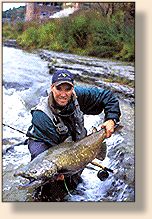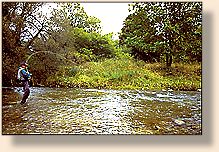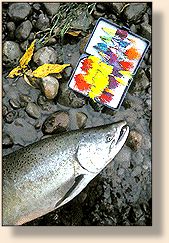Lake Ontario Chinook: Small Stream Tactics
By Chris Marshall, Photos By Glen Hales
Fishing for salmon and migratory trout in the tributaries of Lake Ontario's north
shore is unique, in that there are no large rivers with significant runs.
Moreover, all of them lie west of Trenton. There are tributaries at the
east end, but all are warm water streams. A number of these have incidental
runs of both trout and salmon, and there is some evidence of limited spawning
success of chinook in at least one of them, but the for the fly fisher
the pickings are sparse and unreliable at best. The two largest north
shore tributaries, the Trent (which is huge) and the Moira, both of which
run into the shallow, warm waters of the Bay of Quinte rather than directly
into the lake, are among these. There are also incidental runs in some
of the outlets to Lake Ontario around the shores of Prince Edward County.
However, all the tributaries with significant, self-sustaining runs of
migratory salmonids are located west of Trenton and all are small.

Fishing such streams is very different from fishing the big waters of the tributaries
of the upper Great Lakes, especially for fish as large as chinook. In
some ways, it's easier, for unless the water is running high and stained
from heavy rains, the fish are very visible even in the deeper pools.
Consequently, sight fishing for them is a breeze. However, in these conditions,
they spook easily, and playing big fish in such cramped quarters is less
satisfying than it is the big rivers. But it has its own unique charm
and challenge.
Every species of migratory trout and salmon which inhabit Lake Ontario can be
encountered on the north shore tributaries in the fall. Chinooks, which
produce the heaviest runs, start entering the streams as early as the
middle of August, peak in September, with a few stragglers as late as
the beginning of November. These are followed by coho in September. There
are far fewer of these than chinooks, which is a pity, as they keep their
condition much longer, with vigorous fish available into December. Brown
trout also start showing up in late September and a few will hang around
after spawning on into November. The rainbows, which don't have the same
urgency as the other species (which are all fall spawners) will start
showing up at the mouths and the lower reaches in November, but very few
will move any distance upstream until early spring. Mixed in with these
will be a sprinkling of pink salmon and, on a few streams where they've
been stocked, Atlantic salmon. October also brings in a good number of
lake trout and a few of the rare north shore coaster brook trout, but
as these are out of season at this time, they can't really be counted
as part of the legitimate fishery. Rain plays a major role in the timing
of the runs, as all species tend to hang around at the mouth and move
upstream during post-rainfall freshets. Rainbows, for instance, will even
move back and forth between lake and stream as the flow waxes and wanes.
The primary focus of this feature is on chinooks, but the gear and tactics
described, apply to the other species with only minor modifications.
Chinook Streamcraft Strategies
 While chinook will run upstream during the day if the water is high and stained,
under normal water conditions, they prefer to move at night. Many of the
fish that have made a nocturnal move can be found holding in riffles and
shallow runs early the following morning. However, once they've been disturbed
by anglers, especially those chucking heavy hardware at them, they take
refuge in the deeper pools. When chinook are holding in pools they're
harder to target than when they're holding in shallower water. It's harder
to track the fly visually in the deeper water of pools, and, because the
fish are more densely packed, the chance of inadvertant foul-hooking is
increased significantly.
While chinook will run upstream during the day if the water is high and stained,
under normal water conditions, they prefer to move at night. Many of the
fish that have made a nocturnal move can be found holding in riffles and
shallow runs early the following morning. However, once they've been disturbed
by anglers, especially those chucking heavy hardware at them, they take
refuge in the deeper pools. When chinook are holding in pools they're
harder to target than when they're holding in shallower water. It's harder
to track the fly visually in the deeper water of pools, and, because the
fish are more densely packed, the chance of inadvertant foul-hooking is
increased significantly.
This means that it pays to get to the stream at the crack of
dawn if you want to fish in optimum circumstances.
Techniques
Let's assume that you're an early bird and you've found a pod of chinook holding
in a shallow run. You should position yourself directly opposite or just
downstream from them. Get as close as you need to be so that you can see
your fly as it drifts or swings downstream. If you move carefully and
quietly, you should be able to get as close as 15 feet to them, but if
you can manage from 20 or 25 feet away, so much the better.
The composition of the pod and how much they're involved in
spawning or pre-spawning will determine how you'll tackle them.
When chinook first enter the stream, they're more or less
randomly mixed, but they quickly form into groups
of several males with a single female. Once this has happened, the males
are very susceptible to a jazzy, in-your-face streamer, which they'll
clobber as a potential challenge to their virility.
Therefore, check the fish in the pod carefully. Males have a somewhat longer head
than females and a pronounced kype. They also tend to engage in typical
male behaviour chasing each other and jostling to be first to mate. If
this is what's going on, tie on the most offensive streamer in your box
and swing it across and downstream. You'll get attention from at least
one of the males possibly from all of them.
Both males and females can be tempted, whether they're in a spawning group
or not, with a dead-drifted fly, triggering their instinctive feeding
response with a fly drifted repeatedly across their noses. This is where
it's essential to be in a position from which it's possible to observe
the fly as it drifts and the movement of any fish which might take it.
Simply watch the drift and when you see a mouth open and close on the
fly, set the hook. As chinooks will eat the spawn of other chinooks, egg
patterns work well in these circumstances, but other patterns such as
Spring Wigglers and Woolly Buggers are also effective. Patience is essential
here, as it usually takes repeated drifts to induce a take.
If you've arrived at the water after the fish have been spooked into the
deeper pools, you'll find that they're less willing to hit a fly. In the
deeper water, it's also more difficult to detect a take. Nevertheless,
the same basic techniques apply, it just takes a bit more patience and
concentration.
Hanging in There
Chinook are big fish: the average size is around 20 pounds and
many will approach 30, with the occasional 30 plus specimen.
When you hook one of these on a small stream, it's very different
from hooking one out in the lake or on a river-sized tributary.
Most fish simply head downstream for the lake.
On a small stream (most of which have lots of bends an prolific streamside
vegetation), you have to follow, frequently at a run, when a fish roostertails
through the ubiquitous alder-fringed bends. This means that felt-soled
wading boots are essential to avoid slipping as you rush through slippery
bedrock and boulders.
On small streams, hooked chinook rarely, if ever, jump. However, if you happen
to foul hook one (a regular occurrence when they're packed tight in pools),
prepare for fireworks, especially if you've foul-hooked it in the tail.
Gear
 Because you're targeting big fish in small streams, it's necessary to have gear
which is sturdy enough to stop fish quickly. A 9 weight outfit and a rod
with lots of backbone is ideal. Because the streams are shallow, a floating
line is all you need. It's not necessary to have lots of backing, as you'll
follow the fish on foot. I've never had a small stream chinook take me
into the backing. Because chinook do not spook easily, there's no need
for long, fine leaders and tippets. Four to five feet of 10 pound mono
is quite sufficient. On the few occasions where it's necessary to get
the fly down deep, shot pinched on the leader will do the trick.
~ Chris Marshall
Because you're targeting big fish in small streams, it's necessary to have gear
which is sturdy enough to stop fish quickly. A 9 weight outfit and a rod
with lots of backbone is ideal. Because the streams are shallow, a floating
line is all you need. It's not necessary to have lots of backing, as you'll
follow the fish on foot. I've never had a small stream chinook take me
into the backing. Because chinook do not spook easily, there's no need
for long, fine leaders and tippets. Four to five feet of 10 pound mono
is quite sufficient. On the few occasions where it's necessary to get
the fly down deep, shot pinched on the leader will do the trick.
~ Chris Marshall
Credits: From the Fall 2002 issue of The Canadian Fly Fisher.
We greatly appreciate use permission.
|

